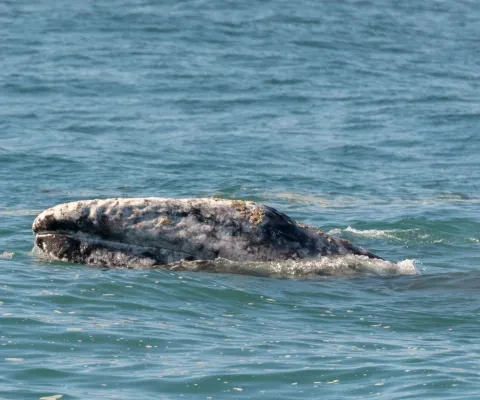Have you spotted a whale yet this year? It's not too late! There's a good chance you can see a whale in April. The entire population of Gray Whales migrates along the California coastline twice a year. At this time of year, Gray Whales are leaving Baja (where they traveled for the winter to mate and give birth), and are traveling north along the coast, making their return journey home to the Arctic. A typical schedule:

Source: Condor Express The migration trip for the Gray Whale is thought to be the longest of any mammal. They cover 10,000 to 14,000 miles round trip, at an average speed of 10 km/h. Really puts your commute to shame, doesn't it? The northern migration often is the easier time to see them, because the whales swim close to shore, with their babies between them and the shore, probably to protect them from sharks. Additionally, they are moving slower against the current with their young calves in tow. According to About.com, your best bet for seeing a whale is to scan the ocean's surface, looking for a spout (a spray of water). Grey whales normally swim in a cycle of 3 to 5 blows, 30 seconds apart, followed by a three- to six-minute dive, and they often show their tail flukes just before they dive. If they're swimming just below the surface and you're high enough to see the water's surface, they may leave a "trail" of circular calm spots on the surface as they pass, making them easier to track.
Great Places to Watch for Whales
So where to go? There are a few great spots to watch for whales; the best being places where the coastline sticks out. Here are three of our favorite state parks with nice vantage points. Bring your binoculars!
Pigeon Point Light Station State Historic Park Pigeon Point has a great vantage point to watch for whales, with the lighthouse perched on a jut of land that reaches farther into the sea. On Thursdays through Mondays in April, volunteers will be available at Pigeon Point from 10 a.m. to 4 p.m. to help spot whales and to answer questions about their annual migration. While you are there, you can also learn about the other marine life that frequent the area, the history of the lighthouse and more.
Julia Pfeiffer Burns State Park There is a wonderful little trail that takes you out to a point that is great for whale watching. In addition you get the best view of McWay Falls from this trail. Whale watchers stand at coastal overlook points in December, January, March and April to watch gray whales migrate; a lucky few have seen gray whales come into the mouth of the cove.
Point Lobos State Natural Reserve They gray whale is the most often spotted whale at the Point, but you can spot other types of whales throughout the year here, as well. Even if you don't spot a whale at these spots, you may still see dolphins, harbor seals, and sea otters, which are always fun. And at the very least, you'll spend a lovely spring day in a state park. Good luck, whale spotters.
